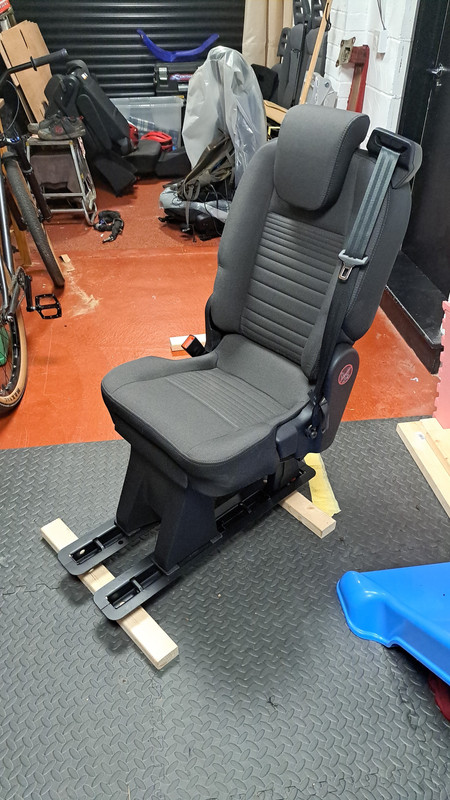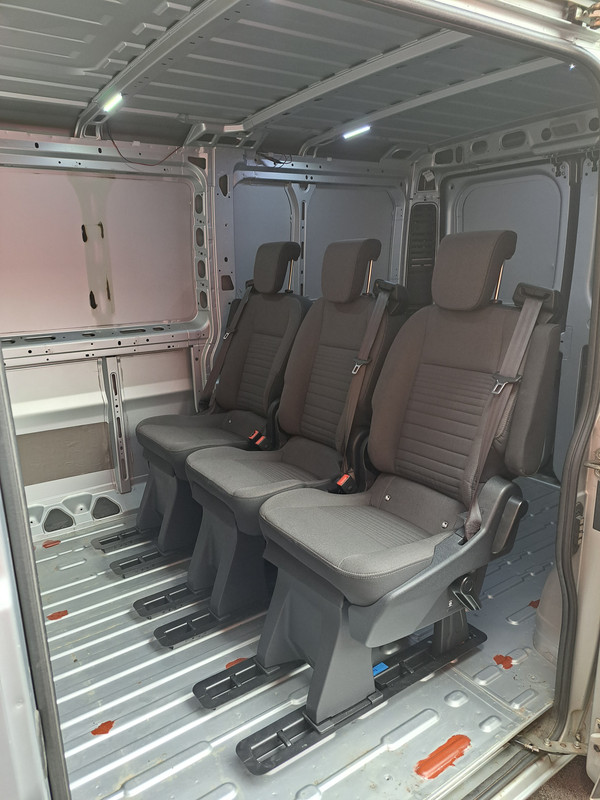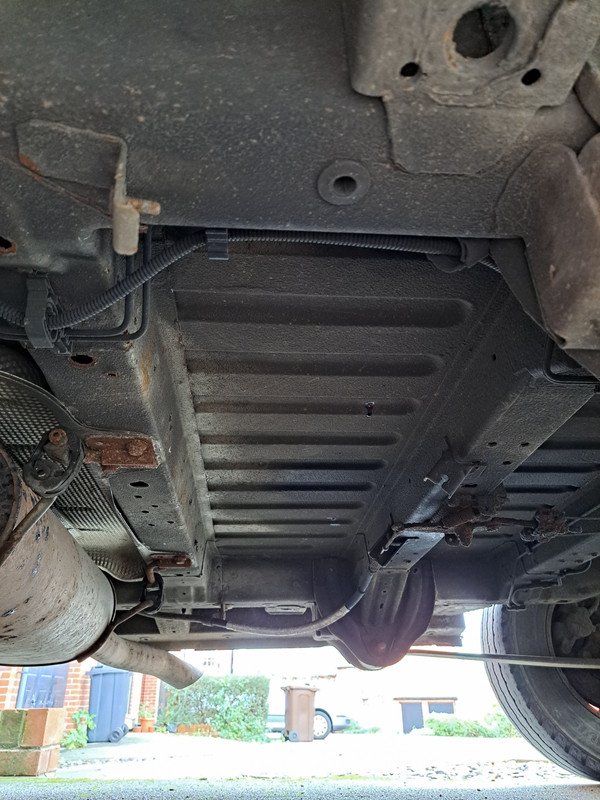- This topic has 18 replies, 12 voices, and was last updated 1 year ago by mick_r.
-
Vanners. How would you fit these rear seats?
-
sharkattackFull MemberPosted 1 year ago
Right, I’ve got a Peugeot Boxer and some posh seats from a Transit Custom that are quick release, built-in seatbelts, isofix etc. I need to nail them in somehow, in a way that won’t endanger the lives of the babies and grandparents strapped into them.
There are 24 nuts and bolts (the factory Ford ones), 4 in each of the 6 rails. I can arrange the seats the way I want them so they sit on the flat part of the floor. I thought I could use lengths of angle iron as spreader plates, but long ones that go perpendicular underneath all 6 rails, tying them all together. Rather than a seperate bit under each nut. Anything wrong with that idea?
The problem is that some of the bolt holes will be obscured by the chassis rails. Any ideas for solidly mounting the rails in the parts where I can’t access the backside? Can you cut big holes in a chassis rail to access a bolt?
This is what we’re dealing with…
These things are bloody heavy!!!
I’m willing to pay to have this done professionally but I’ve already been denied by a couple of local (Sheffield) firms. One welding/fabrication place say their insurance won’t cover them and a van conversion place said they can’t because they don’t do welding or fabrication.
For the past 6 weeks I’ve been thinking I should sell the lot and buy a Jimny and a bike rack. If I can get past this blockage I’ll hopefully get my mojo back.
Thanks all.
phil5556Full MemberPosted 1 year agoNot sure if this will work, you might have to join the FB group to see it but this guy made some decent looking mountings up. https://www.facebook.com/groups/688778414645172/permalink/1627782770744727/
I’ve seen plenty of terrible looking efforts so you’re right to want it done properly. He also fitted a side impact bar behind the driver to protect his new seats.
https://www.facebook.com/groups/688778414645172/permalink/1612123125644025/
falkirk-markFull MemberPosted 1 year agoExtra long bolts or screwed rod for through leg a possibility. deffo wouldn’t cut actual holes in rails. also you could mount seats on say a 6mm plate with countersunk bolts and then once seats bolted onto plate then bolt plate onto floor where you can screw onto floor where there are no chassis rails (put some plate underneath to ensure thin plate van floor doesn’t rip in crash) Also You tube search will give options to you
ginksterFull MemberPosted 1 year agoMaybe some specific rails and quick release attachments would work and give you added flexibility. This company does various types. I have the campervan kit in my van.
maccruiskeenFull MemberPosted 1 year agoOne welding/fabrication place say their insurance won’t cover them and a van conversion place said they can’t because they don’t do welding or fabrication.
Check your own insurance situation first. I spoke to van dealer a few years back who’d stopped fitting rear seats aftermarket because customers weren’t able to insure the van once converted.
trail_ratFree MemberPosted 1 year agoI’d be wanting reinforcing above also unless mounted directly over a chassis member.
Van floor alone won’t resist rotational load punch through in a frontal impact.
BearBackFree MemberPosted 1 year agoI want to replace the seats in my north american 15 passenger van. the current seats from 2004, even on currently available models don’t have head rests at all!
There are loads of tear out sprinter and transit seats that would suit this purpose.. however whilst I’m confident i could install these to be safer than the factory solution, that I’d almost certainly not be insured in the event of a Collison/injury is preventing me spending the time/money to do so.
Step 1 would be to ask your insurer if its even covered.mick_rFull MemberPosted 1 year agoI’ve done seat belt anchorage tests on converted vehicles and seen plenty of failures.
Ideally I’d be wanting the rearmost two rail bolts just infront / behind that rear crossmember, mating with fabricated spreader brackets under the vehicle so you are clamping both the floor panel and fully around the crossmember. No idea if the bolt spacing is wide enough to allow that.
Not sure where that leaves the front bolts. Ideally you want the front of the rails overlapping that front crossmember so they don’t punch through the floor, but you could use an inside vehicle spreader plate to achieve that.
Your angle section spreaders under the floor aren’t a bad idea. Channel would be better than angle, and you want to be tying into / around the crossmembers, not just through the flat bit of floor. I’d be getting a fabricator with press brake to make a length of bespoke channel with one short stiffer leg and a long leg to mate with the crossmembers.
Don’t use threaded rod – it is garbage. If you need long bolts then order 12.9 grade capheads or similar. I’ve seen failures where purchasing buyer thought it was ok to save a few pence swapping high grade bolts for threaded rod…..
All this is just slightly more informed than normal internet advice – you are doing this at your own risk….
oldschoolFull MemberPosted 1 year agoThe spreader bars underneath is great, but especially as you have built in seatbelts you really need to consider the rail pushing down at the front and ‘punching’ through in the down direction as the rear try’s to lift up.
As the poster above, you’d need to be tying in/straddling the chassis cross members.boxelderFull MemberPosted 1 year agoHave a look at the kits used to mounts RIB beds – sort of spreader plates bolted to cross members and then bolted through to fit seats. Clearcut Campers
tillydogFree MemberPosted 1 year agoThere are rules & guidance for this stuff – essential to follow it if you want to get an MOT.
Read up on the seatbelt requirements
mick_rFull MemberPosted 1 year agoJust be aware that those guidance notes are for vehicles with more than 8 passenger seats i.e. minibuses which are M2 or bigger buses / coaches which are M3.
The OPs vehicle is M1 / N1 which is much bigger loads than the M2 and M3 Type Approval tests. So the general advice is good, but probably not beefy enough for an M1 installation.
sharkattackFull MemberPosted 1 year agoThanks for all the info there’s a lot of useful stuff here. It’s all stuff I already basically knew, such as heavily reinforce all mounting points and tie around the huge chassis rails rather than go through them. That still leaves me with the problem of finding someone to do the work as I’m not really set up for it at home.
I’ve been dealing with my other nightmare all day today, the collapsed bedroom ceiling.
I’ll jump in the van tomorrow and shuffle the seats around. They’re so bloody heavy that getting them in and out or putting them in the right spot is very hard work. I’ll find out how many bolt holes I can tie together with U-channel steel and how many I can’t access.
If anyone knows a good metalworker in Sheffield I’m all ears.
tillydogFree MemberPosted 1 year agoJust be aware that those guidance notes are for vehicles with more than 8 passenger seats
I understood that the guidance section (10.2) applied to “normal” vehicles (i.e cars & light commercial).
(In the absence of a load-tested design.)
mick_rFull MemberPosted 1 year agoWell as I’m reading it, section 10 only applies to:
10. Seat belt installation checks
Seat belt installation rules and inspection for vehicles fitted with more than 8 passenger seats and first used before 1 October 2001.10.2 is a subsection of section 10 and only discusses minibuses and buses / coaches.
More than 8 seats is M2. And from memory that is HALF the test load (forces due to 10g deceleration not M1 20g).
tillydogFree MemberPosted 1 year agoWell as I’m reading it…
Not arguing with you (honest! – you seem to have some experience in this area), but the class 4A check is what is *recommended* (rather than *required*) for additional seats fitted to vans (from here):
There is no formal checking procedure for private conversions. However, if you have installed new seatbelts, it is advisable that you submit your vehicle for a seatbelt installation check (a class IVa check) which can be carried out as part of the annual MOT test.
Anyway, I hope we’d concur that compliance with that guidance would be the *minimum* that would be required (rather than copying random ideas presented on arse-book). It’s also something that is defensible should the installation be queried in the future.
(When I looked into this a few years ago, I couldn’t find any guidance applicable to DIY installations other than the above – the next step up seemed to be a pull tested design which is obviously beyond sensible DIY scope.)
jonesyboyFull MemberPosted 1 year agoI got mine fitted by Motorkraft in Stoke, they issued a certificate as they are an approved installer for a few brands of seats.
Plates above and below the floor with high tensile bolts, all supplied by seat manufacturer. Insurer wanted certificate and photo of seats.
sharkattackFull MemberPosted 1 year agoJust in case anyone is concerned, I could have got much less expensive seats and screwed them down with self tappers. However I plan to carry my infant son using his childseat and the isofix points. Whatever I do it’ll be well in excess of whatever you find in a standard van.
I’ve read all that stuff about van conversions before and I know there’s no formal checks. My insurance company just want a picture of the installation after it’s done.
mick_rFull MemberPosted 1 year agoNo probs Tilly – it is really good people are researching and thinking about it. I think the original version of that gov document was written by the now defunct STATUS test facility at Man Met Uni when retrofit of minibus seatbelts first because a thing.
The tests destroy the seat and bodyshell so they are impossible to do on a one-off basis. All people can do is fit M1 seats (which the OP has) and go with a thorough / best guess installation using good basic principles.
As reassurance for sharkattack – the tests are a real extreme case. We don’t do the tests on my site anymore so I can’t remember the exact numbers, but it is something like 20x a very big person in every seat position in the row, plus 20x the mass of the seat and all attachment brackets (applied at the c of g or added to the lap belt loads). I doubt you are going to have anything like that passenger load 🙂.
The test also favours good engineering, strong and light structural sections made from good materials. Brick outhouse structurally inefficient thick steel plates just ramp up the required test load. I’ve occasionally seen people go round the loop of beefing up a borderline failure, add mass, thus increasing the test load and then fail again….
You must be logged in to reply to this topic.


